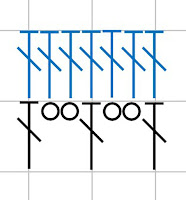After last months frustrating encounter with Victorian Crochet Lace I thought we would try something more reliable and easily achievable! I've previously avoided Filet Lace as I thought it was so simple that there was nothing much to say. Let's see if I can surprise you!
 |
| A pattern repeat of a design in Imitation of Filet-Guipure. |
The idea to begin a series on crochet Lace came to life after noticing that many of the lace patterns in the Therese De Dillmont 1886 Encyclopedia of Needlework use the words, in 'imitation of...'. It was at that point I realised that crochet lace did not appear in a vacuum but came from somewhere else and that all crochet lace was not the same. So where does Filet crochet come from?
Modern Filet most closely resembles filet Richelieu.
Once the net is made it is 'strung' in a frame. Areas of the net are blocked in with a finer needle with smooth Darning Stitches of the type used in tapestry and canvas work, or with Woven stitches across the net squares.More organic shapes are achieved by working Stem stitch over the design with a thicker thread. Finally the whole net is edged with button hole stitch.
The crochet filet patterns in Dillmont's encyclopedia are in imitation of Filet Guipure. This is a slightly more complex style with the patterns preferring more geometric patterns than the organic imagery of Richelieu. As well as the Darning and Woven stitches, Guipure also employs Herringbone weaving,triangles and wheels, somewhat reminiscent of Dorset buttons.In an embroidery dictionary you should find all these stitches under 'canvas work'.
But we're not here to talk about embroidery, or lace for that matter. We're here to talk about crochet!
This exquisite piece of work was also in my heirloom box. To get a sense of scale there are 20 bocks to 10cm.
As we discovered last month, Victorian crochet patterns are not easy to follow. So, you can understand how Filet work must have been popular, as it is easy to copy from an image alone. These days patterns are shown as charts. Each square shown either filled or empty. The frame work of the square which represents our netting is a Treble high (Dc-US) and 2chains wide. If a block is filled, the 2 chain are replaced with 2 Treble (Dc-US). Designs worked in this way are most like Richelieu, and the patterns often pictorial or organic.
The castellated edging, which in the original net lace is created using Buttonhole stitch, is achieved by extending alternate rows. To extend the next row work 3Chain followed by 3 starting-chain and then continue to work the row according to the design.
To extend the same row, which can only be done if it is a filled block, work Foundation-Treble. (Foundation-Dc)- US). For a design to be in imitation of Guipure, the Herringbone stitches are represented by working Lacets. A Lacet is Ch3-Dc-Ch3 (Ch3-Sc-Ch3 - US) in the first row and the two blocks left empty on the second. They are worked over a 2x2 block like this.
Alternatively, they can be made by mixing filled and/or empty 2x2 blocks with 4 empty1x1 blocks, by which I mean like this.
It may have occurred to you that the image above is impossible! It is taken from one of the designs in the Dillmont Encyclopedia, which I made to work out how it was done.
The answer is that the chain stitches are made on row-a and borrowed by row-b. The design is made like this, with the chain caught up by slip stitches on row-b.
 |
| One Pattern repeat of a design in Imitation of Filet-Guipure. |
My under-praised but highly-valued researcher has been bombarding me with ideas by which we might modernise Filet crochet. She pointed out that Fay Dashper Hughes' Herringbone inspired Positivity Spiral (hooked here by me) is really Filet crochet. Any good Crochet Dictionary will also show you numerous ways in which we have already been doing this. Betty Barndon suggests jazzing the lacets up with a picot or adding Solomon's loops.
Linda Schapper offers any number of variations even going so far as to toss in the odd fan. I suppose at some point we might ask ourselves if it is still Filet. But does it matter if it takes us somewhere new?
Alternatively should we rediscover something that we have clearly forgotten? This design clearly shows crochet Filet with sewn embellishment.
 |
| Colour plate from the Dillmont Encyclopedia |
I shall leave you to decide on that while I go in search of more new old things...
























Interesting when you think about the origin and the context like this. And isn't this the curse of crochet: it is so flexible that it can imitate almost anything, but instead of being appreciated for this, it is reduced to being "second best"! Never as good as the original.
ReplyDeleteWhat you said! Flexible, surprising and endlessly evolving, what's not to love?!
ReplyDelete